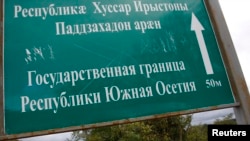Efforts to save the Ossetian language are running up against a host of problems on both sides of Russia's border with a breakaway Georgian republic, contributing to fears that both forms of Ossetian might ultimately slip into obscurity.
And with a history of dispute over its dialects, disregard under the Soviet-era Georgian education system, and competing visions of its place in public life, Ossetian is likely to continue to pose obstacles to cooperation on the language front between North and South Ossetia.
Over the past decade, officials and intellectuals in both Russia's Republic of North Ossetia-Alania and Georgia's breakaway and largely unrecognized Republic of South Ossetia have expressed concern over the steadily dwindling number of people who actually speak Ossetian.
Reflecting that decline, UNESCO in 2009 designated the language as "vulnerable," the first category in its four-tier classification of languages at risk of disappearing.
But Ossetians in the two polities in fact speak different forms of the language, which creates obstacles to cooperation between them to avert the danger that in time both dialects will become extinct.
Ossetian is an Indo-European language, belonging to the eastern branch of the Indo-Iranian group, with an estimated 450,000-500,000 speakers, the overwhelming majority of them in North Ossetia.
Of the two Ossetian dialects, Digor is spoken in the west of the Republic of North Ossetia-Alania and in neighboring Kabardino-Balkaria, and Iron in the east of North Ossetia and in South Ossetia. Speakers of Iron reportedly outnumber speakers of Digor by 5 to 1.
Divided By A Common Language
The two Ossetian dialects are sufficiently different as not to be mutually comprehensible. There are, for example, some 2,500 words in Digor that do not exist in Iron. Until 1937, Digor was in fact considered a separate language, and some North Ossetian scholars still argue that Iron and Digor are both full-fledged languages, rather than mere dialects. The phonetic, morphological, and lexical differences between them appear to be greater than between Chechen and Ingush, according to Aslan Doukaev of RFE/RL's North Caucasus Service.
Most speakers of Digor can understand Iron, but not vice versa. The North Ossetian constitution mentions both dialects as the state language, but, for reasons that remain unclear, the republican parliament has still not passed the law on the state languages drafted in 2005. North Ossetian State TV launched a program in Digor four years ago.
At the time of the 2010 All-Russia census, there were 459,688 Ossetians in North Ossetia, of whom 455,328 claimed a knowledge of "Ossetian." But an informal survey conducted by journalists in Vladikavkaz, the North Ossetian capital, last year casts doubt on those statistics. Of an unspecified number of people whom they questioned on the street, 36 percent claimed to speak Ossetian fluently, 32 percent to speak it well, and 11 percent to speak it badly. But when addressed in Ossetian rather than Russian, even some of those who claimed to speak the language fluently proved unable to reply coherently in Ossetian.
Cognizant of the danger that the Ossetian language could die out within a couple of generations, the North Ossetian authorities have adopted two successive programs (2008-12 and 2013-2015) to promote the study of the Digor variant of Ossetian among the younger generation, whose parents in many cases do not speak the language themselves and are thus unable to hand it on to their children. Ossetian is a compulsory subject in all schools and kindergartens, and a vast range of new textbooks in Digor has been commissioned in preparation for selected schools to switch to Ossetian as the language in which all other subjects are taught.
Missing Vowel
The second (2012-15) state program envisaged expanding the use of Ossetian online. This is proving problematic, however, given the widespread use in Ossetian of a character (æ) that does not exist in Cyrillic. Philologist Tamerlan Kambolov explained that the most commonly used software both in North Ossetia and elsewhere in Russia is Microsoft, and only the Russian government is empowered to request the creation of a special program that would reflect the nuances of the Ossetian alphabet. Currently, Ossetian language materials, such as the online version of the newspaper Ræstdzinad (Truth) substitute a different vowel for the character in question.
South Ossetia, too, has adopted a state program for the development of the Ossetian language that, like its North Ossetian counterpart, focuses in the first instance on intensive teaching of the language in kindergartens. Other planned initiatives, such as the publication of the third volume of an Ossetian dictionary and the launch of a TV talk show in Ossetian aimed at the younger generation, have apparently been shelved due to lack of funds. The republic is heavily dependent on subsidies from Moscow, which recognized South Ossetia as an independent state in the wake of the August 2008 Russian-Georgian war.
The Treaty on Union Relations and Integration signed by the Russian Federation and the Republic of South Ossetia in March obliges Russia to provide assistance to South Ossetia in developing Russian and Ossetian, both of which are designated in South Ossetia's Constitution as state languages. But, as noted above, the differences between Iron and Digor constitute a major obstacle to cooperation on the language front between North and South Ossetia. In that respect, the long-term survival of Iron currently appears more precarious than that of Digor, even though it is spoken by a larger number of people.
-- Liz Fuller
